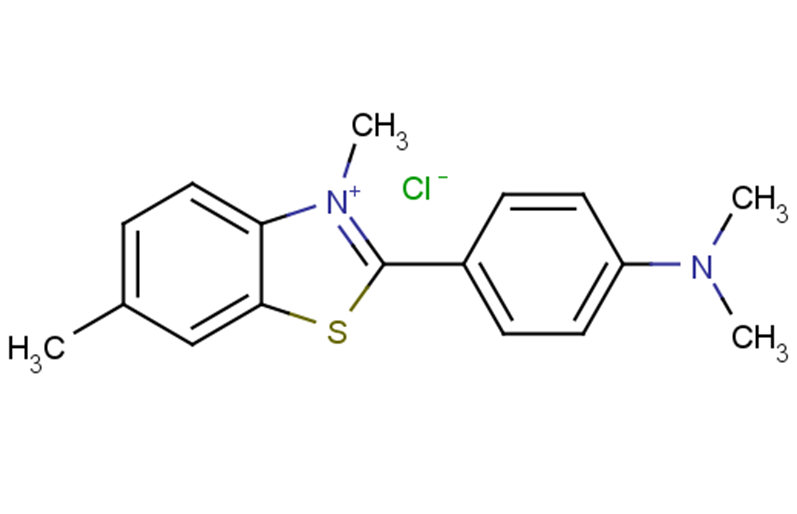
Thioflavin T
CAS No. 2390-54-7
Thioflavin T( Basic Yellow 1 )
Catalog No. M22677 CAS No. 2390-54-7
Thioflavin T is a widely used dye for visualizing and is a cationic Benzothiazole dye that shows enhanced fluorescence upon binding to amyloid in tissue sections.Thioflavin T (ThT) is a benzothiazole dye that exhibits enhanced fluorescence upon binding to amyloid fibrils and is commonly used to diagnose amyloid fibrils, both ex vivo and in vitro.
Purity : >98% (HPLC)
 COA
COA
 Datasheet
Datasheet
 HNMR
HNMR
 HPLC
HPLC
 MSDS
MSDS
 Handing Instructions
Handing Instructions
| Size | Price / USD | Stock | Quantity |
| 1G | 26 | In Stock |


|
Biological Information
-
Product NameThioflavin T
-
NoteResearch use only, not for human use.
-
Brief DescriptionThioflavin T is a widely used dye for visualizing and is a cationic Benzothiazole dye that shows enhanced fluorescence upon binding to amyloid in tissue sections.Thioflavin T (ThT) is a benzothiazole dye that exhibits enhanced fluorescence upon binding to amyloid fibrils and is commonly used to diagnose amyloid fibrils, both ex vivo and in vitro.
-
DescriptionThioflavin T is a widely used dye for visualizing and is a cationic Benzothiazole dye that shows enhanced fluorescence upon binding to amyloid in tissue sections.Thioflavin T (ThT) is a benzothiazole dye that exhibits enhanced fluorescence upon binding to amyloid fibrils and is commonly used to diagnose amyloid fibrils, both ex vivo and in vitro. Changes in the fluorescence excitation and emission of Thioflavin T are also dependent on the micelle formation. The Thioflavin T micelles of 3 nm diameter are directly visualized using atomic force microscopy, and bound Thioflavin T micelles are observed along the fibril length for representative fibrils. The micelles of Thioflavin T bind amyloid fibrils leading to enhancement of fluorescence emission[1]. In aqueous solutions, Thioflavin T is found to exist as micelles at concentrations commonly used to monitor fibrils by fluorescence assay (~10-20 μM). Specific conductivity changes are measured at varying concentration of Thioflavin T and the critical micellar concentration is calculated to be 4.0±0.5 μM. Increasing concentration of Thioflavin T above the critical micellar concentration shows increased numbers of micelles bound along the length of the amyloid fibrils. Thioflavin T micelles are disrupted at low pH as observed by atomic force microscopy and fluorescence enhancement upon binding of Thioflavin T to amyloid fibrils also reduced by several-fold upon decreasing the pH to below 3.(In Vitro):Thioflavin T (ThT) is a benzothiazole dye that exhibits enhanced fluorescence upon binding to amyloid fibrils and is commonly used to diagnose amyloid fibrils, both ex vivo and in vitro. In aqueous solutions, Thioflavin T is found to exist as micelles at concentrations commonly used to monitor fibrils by fluorescence assay (~10-20 μM). Specific conductivity changes are measured at varying concentration of Thioflavin T and the critical micellar concentration is calculated to be 4.0±0.5 μM. Changes in the fluorescence excitation and emission of Thioflavin T are also dependent on the micelle formation. The Thioflavin T micelles of 3 nm diameter are directly visualized using atomic force microscopy, and bound Thioflavin T micelles are observed along the fibril length for representative fibrils. Increasing concentration of Thioflavin T above the critical micellar concentration shows increased numbers of micelles bound along the length of the amyloid fibrils. Thioflavin T micelles are disrupted at low pH as observed by atomic force microscopy and fluorescence enhancement upon binding of Thioflavin T to amyloid fibrils also reduced by several-fold upon decreasing the pH to below 3.The micelles of Thioflavin T bind amyloid fibrils leading to enhancement of fluorescence emission.
-
In Vitro——
-
In Vivo——
-
SynonymsBasic Yellow 1
-
PathwayOthers
-
TargetOther Targets
-
RecptorOthers
-
Research Area——
-
Indication——
Chemical Information
-
CAS Number2390-54-7
-
Formula Weight318.86
-
Molecular FormulaC17H19ClN2S
-
Purity>98% (HPLC)
-
SolubilityDMSO:21.5 mg/mL(67.43 mM);H2O:12.5 mg/mL (39.20 mM; Need ultrasonic)
-
SMILES[Cl-].CN(C)c1ccc(cc1)-c1sc2cc(C)ccc2[n+]1C
-
Chemical Name——
Shipping & Storage Information
-
Storage(-20℃)
-
ShippingWith Ice Pack
-
Stability≥ 2 years
Reference
1. Khurana R, et al. Mechanism of thioflavin T binding to amyloid fibrils. J Struct Biol. 2005 Sep;151(3):229-38.
molnova catalog



related products
-
Gabapentin HCl
Gabapentin HCl is a GABA analogue, used to treat seizures and neuropathic pain.
-
Kisspeptin-10, human
Kisspeptin-10, human is an effective vasoconstrictor and inhibitor of angiogenesis.
-
Taraxeryl acetate
Taraxeryl acetate shows the significant antiviral activity against herpes simplex virus (type II). It has less effect on cell cycle arrest and apoptosis of AGS cells than taraxerol.



 Cart
Cart
 sales@molnova.com
sales@molnova.com


